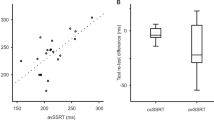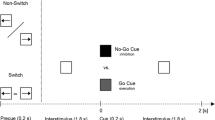Abstract
Parkinson’s disease (PD) patients have longer reaction time (RT) than age-matched control subjects. During the last decades, conflicting results have been reported regarding the source of this deficit. Here, we addressed the possibility that experimental inconsistencies originated in the composite nature of RT responses. To investigate this idea, we examined the effect of PD on different processes that compose RT responses. Three variables were manipulated: the signal quality, the stimulus–response compatibility and the foreperiod duration. These variables have been shown to affect, respectively, the ability to extract the relevant features of the stimulus (perceptual stage), the intentional selection of the motor response (cognitive stage) and the implementation of the muscle command (motor stage). Sixteen PD patients were tested on and off-medication and compared with an age and gender-matched control group. Results indicated that degrading the legibility of the response stimulus affected the latency of simple key-press movements more dramatically in the off-medication PD group than in the control population. The stimulus–response compatibility and the foreperiod duration had similar effects in the two groups. Interestingly, the response slowing associated with the degradation of the stimulus was the same whether the patients were on or off dopaminergic medication. This suggests that the high-level perceptual deficits observed in the present study do not have a dopaminergic origin.



Similar content being viewed by others
References
Bachmann T, Asser T, Sarv M, Taba P, Lausvee E, Poder E, Kahusk N, Reitsnik T (1998) Speed of elementary visual recognition operations in Parkinson’s disease as measured by the mutual masking method. J Clin Exp Neuropsychol 20:118–134
Berardelli A, Rothwell JC, Thompson PD, Hallett M (2001) Pathophysiology of bradykinesia in Parkinson’s disease. Brain 124:2131–2146
Bertelson P (1967) The time course of preparation. Q J Exp Psychol 19:272–279
Bonin-Guillaume S, Blin O, Hasbroucq T (2004) An additive factor analysis of the effect of depression on the reaction time of old patients. Acta Psychol 117:1–11
Broussolle E, Dentresangle C, Landais P, Garcia-Larrea L, Pollak P, Croisile B, Hibert O, Bonnefoi F, Galy G, Froment JC, Comar D (1999) The relation of putamen and caudate nucleus 18F-Dopa uptake to motor and cognitive performances in Parkinson’s disease. J Neurol Sci 166:141–151
Brown P, Marsden CD (1998) What do the basal ganglia do? Lancet 351:1801–1804
Courtiere A, Hardouin J, Vidal F, Possamai CA, Hasbroucq T (2003) An additive factor analysis of the effect of sub-anaesthetic doses of nitrous oxide on information processing: evidence for an impairment of the motor adjustment stage. Psychopharmacology 165:321–328
Davranche K, Audiffren M (2002) Effects of a low dose of transdermal nicotine on information processing. Nicotine Tob Res 4:275–285
Davranche K, Audiffren M (2004) Facilitating effects of exercise on information processing. J Sports Sci 22:419–428
Deary IJ, Simonotto E, Meyer M, Marshall A, Marshall I, Goddard N, Wardlaw JM (2004) The functional anatomy of inspection time: an event-related fMRI study. Neuroimage 22:1466–1479
DeJong R, Liang C, Lauber E (1994) Conditional and unconditional automaticity: a dual-process model of effects of spatial stimulus–response correspondence. J Exp Psychol Hum Percept Perform 20:731–750
Desmurget M, Grafton ST, Vindras P, Grea H, Turner RS (2003) Basal ganglia network mediates the control of movement amplitude. Exp Brain Res 153:197–209
Desmurget M, Grafton ST, Vindras P, Grea H, Turner RS (2004) Basal ganglia network mediates the planning of movement amplitude. Eur J Neurosci 153:197–209
Djamgoz MB, Hankins MW, Hirano J, Archer SN (1997) Neurobiology of retinal dopamine in relation to degenerative states of the tissue. Vis Res 37:3509–3529
Fielding J, Georgiou-Karistianis N, Bradshaw J, Millist L, White O (2005) No sequence dependent modulation of the Simon effect in Parkinson’s disease. Brain Res Cogn Brain Res 25:251–260
Fitts PM, Deininger RL (1954) S-R compatibility: correspondence among paired elements within stimulus and response codes. J Exp Psychol 48:483–492
Folstein MF, Folstein SE, McHugh PR (1975) Mini-mental state. A practical method for grading the cognitive state of patients for the clinician. J Psychiatr Res 12:189–198
Frith CD, Done DJ (1986) Routes to action in reaction time tasks. Psychol Res 48:169–177
Gauntlett-Gilbert J, Brown VJ (1998) Reaction time deficits and Parkinson’s disease. Neurosci Biobehav Rev 22:865–881
Godaux E, Koulischer D, Jacquy J (1992) Parkinsonian bradykinesia is due to depression in the rate of rise of muscle activity. Ann Neurol 31:93–100
Growdon JH, Kieburtz K, McDermott MP, Panisset M, Friedman JH (1998) Levodopa improves motor function without impairing cognition in mild non-demented Parkinson’s disease patients. Parkinson Study Group. Neurology 50:1327–1331
Hasbroucq T, Mouret I, Seal J, Akamatsu M (1995) Finger pairings in two-choice reaction time tasks: does the between-hands advantage reflect response preparation? J Mot Behav 27:251–262
Hasbroucq T, Kaneko H, Akamatsu M, Possamai CA (1997) Preparatory inhibition of cortico-spinal excitability: a transcranial magnetic stimulation study in man. Brain Res Cogn Brain Res 5:185–192
Hasbroucq T, Osman A, Possamai CA, Burle B, Carron S, Depy D, Latour S, Mouret I (1999) Cortico-spinal inhibition reflects time but not event preparation: neural mechanisms of preparation dissociated by transcranial magnetic stimulation. Acta Psychol 101:243–266
Hasbroucq T, Tandonnet C, Micallef-Roll J, Blin O, Possamai CA (2003) An electromyographic analysis of the effect of levodopa on the response time of healthy subjects. Psychopharmacology 165:313–316
Hayes AE, Davidson MC, Keele SW, Rafal RD (1998) Toward a functional analysis of the basal ganglia. J Cogn Neurosci 10:178–198
Hoehn MM, Yahr MD (1967) Parkinsonism: onset, progression and mortality. Neurology 17:427–442
Jackson S, Houghton G (1995) Sensorimotor selection and the basal ganglia: a neural network model. In: Houk J, Davis J, Beiser D (eds) Models of information processing in the basal ganglia. MIT Press, Cambridge, pp 337–368
Jackson GR, Owsley C (2003) Visual dysfunction, neurodegenerative diseases, and aging. Neurol Clin 21:709–728
Jahanshahi M, Brown RG, Marsden CD (1992) The effect of withdrawal of dopaminergic medication on simple and choice reaction time and the use of advance information in Parkinson’s disease. J Neurol Neurosurg Psychiatr 55:1168–1176
Jenkins IH, Fernandez W, Playford ED, Lees AJ, Frackowiak RS, Passingham RE, Brooks DJ (1992) Impaired activation of the supplementary motor area in Parkinson’s disease is reversed when akinesia is treated with apomorphine. Ann Neurol 32:749–757
Johnson AM, Almeida QJ, Stough C, Thompson JC, Singarayer R, Jog MS (2004) Visual inspection time in Parkinson’s disease: deficits in early stages of cognitive processing. Neuropsychologia 42:577–583
Kornblum S, Hasbroucq T, Osman A (1990) Dimensional overlap: cognitive basis for stimulus–response compatibility. A model and taxonomy. Psychol Rev 97:253–270
Kropotov JD, Etlinger SC (1999) Selection of actions in the basal ganglia-thalamocortical circuits: review and model. Int J Psychophysiol 31:197–217
Labyt E, Devos D, Bourriez JL, Cassim F, Destee A, Guieu JD, Defebvre L, Derambure P (2003) Motor preparation is more impaired in Parkinson’s disease when sensorimotor integration is involved. Clin Neurophysiol 114:2423–2433
Lennie P (1998) Single units and visual cortical organization. Perception 27:889–935
Low KA, Miller J, Vierck E (2002) Response slowing in Parkinson’s disease: a psychophysiological analysis of premotor and motor processes. Brain 125:1980–1994
Mann DM, Yates PO (1983) Pathological basis for neurotransmitter changes in Parkinson’s disease. Neuropathol Appl Neurobiol 9:3–19
Marien MR, Colpaert FC, Rosenquist AC (2004) Noradrenergic mechanisms in neurodegenerative diseases: a theory. Brain Res Brain Res Rev 45:38–78
Marx M, Bodis-Wollner I, Bodak P, Harnois C, Mylin L, Yahr M (1986) Temporal frequency-dependent VEP changes in Parkinson’s disease. Vision Res 26:185–193
Nissen MJ (1977) Stimulus intensity and information processing. Percept Psychophysiol 22:338–352
Pillon B, Dubois B, Bonnet AM, Esteguy M, Guimaraes J, Vigouret JM, Lhermitte F, Agid Y (1989) Cognitive slowing in Parkinson’s disease fails to respond to levodopa treatment: the 15–objects test. Neurology 39:762–768
Playford ED, Jenkins IH, Passingham RE, Nutt J, Frackowiak RS, Brooks DJ (1992) Impaired mesial frontal and putamen activation in Parkinson’s disease: a positron emission tomography study. Ann Neurol 32:151–161
Praamstra P, Plat FM (2001) Failed suppression of direct visuomotor activation in Parkinson’s disease. J Cogn Neurosci 13:31–43
Praamstra P, Stegeman DF, Cools AR, Horstink MW (1998) Reliance on external cues for movement initiation in Parkinson’s disease. Evidence from movement-related potentials. Brain 121:167–177
Praamstra P, Plat EM, Meyer AS, Horstink MW (1999) Motor cortex activation in Parkinson’s disease: dissociation of electrocortical and peripheral measures of response generation. Mov Disord 14:790–799
Rafal RD, Posner MI, Walker JA, Friedrich FJ (1984) Cognition and the basal ganglia. Separating mental and motor components of performance in Parkinson’s disease. Brain 107:1083–1094
Redgrave P, Prescott TJ, Gurney K (1999) The basal ganglia: a vertebrate solution to the selection problem? Neuroscience 89:1009–1023
Reeve TG, Proctor RW (1990) The salient features coding principle for spatial- and symbolic-compatibility effects. In: Proctor RW, Reeve TG (eds) Stimulus–response compatibility: an integrated perspective. Adv Psychol, vol 65. North-Holland, Amsterdam, pp 163–180
Ridderinkhof KR, van der Molen MW (1995) When global information and local information collide: a brain potential analysis of the locus of interference effects. Biol Psychol 41: 29–53
Rihet P, Possamai CA, Micallef-Roll J, Blin O, Hasbroucq T (2002) Dopamine and human information processing: a reaction-time analysis of the effect of levodopa in healthy subjects. Psychopharmacology 163:62–67
Robbins TW (1997) Arousal systems and attentional processes. Biol Psychol 45:57–71
Robbins TW, Brown VJ (1990) The role of the striatum in the mental chronometry of action: a theoretical review. Rev Neurosci 2:181–213
Sanders AF (1980) Stage analysis of reaction processes. In: Stelmach GE, Requin J (eds) Tutorials in motor behaviour. North-Holland, Amsterdam, pp 331–354
Sanders AF (1983) Towards a model of stress and human performance. Acta Psychol 53:61–97
Sanders AF (1998) Elements of human performance: reaction processes and attention in human skills. Laurence Erlbaum, Mahwah
Shipley BA, Deary IJ, Tan J, Christie G, Starr JM (2002) Efficiency of temporal order discrimination as an indicator of bradyphrenia in Parkinson’s disease: the inspection time loop task. Neuropsychologia 40:1488–1493
Spijkers WAC, Walter A (1985) Response processing stages in choice reactions. Acta Psychol 58:191–204
Sternberg S (1969) The discovery of processing stages: extensions of Donders’ method. Acta Psychol 30:276–315
Sternberg S (2001) Separate modifiability, mental modules, and the use of pure and composite measures to reveal them. Acta Psychol 106:147–246
Tandonnet C, Burle B, Vidal F, Hasbroucq T (2003) The influence of time preparation on motor processes assessed by surface Laplacian estimation. Clin Neurophysiol 114:2376–2384
Turner RS, Desmurget M, Grethe J, Crutcher MD, Grafton ST (2003) Motor subcircuits mediating the control of movement extent and speed. J Neurophysiol 90:3958–3966
Van Der Molen MW, Bashore TR, Halliday R, Callaway E (1991) Chronopsychophysiology: mental chronometry augmented with physiological measures. In: Jennings JR, Coles MGH (eds) Handbook of cognitive psychophysiology, Wiley, Chichester, pp 9–178
Werheid K, Ziessler M, Nattkemper D, von Cramon DY (2003) Sequence learning in Parkinson’s disease: the effect of spatial stimulus–response compatibility. Brain Cogn 52:239–249
Winer BJ (1971) Statistical principles in experimental design. McGraw Hill, London
Wylie SA, Stout JC, Bashore TR (2005) Activation of conflicting responses in Parkinson’s disease: evidence for degrading and facilitating effects on response time. Neuropsychologia 43:1033–1043
Zhang HH, Zhang J, Kornblum S (1999) A parallel distributed processing model of stimulus-stimulus and stimulus–response compatibility. Cognit Psychol 38:386–432
Zimmermann P, Sprengelmeyer R, Fimm B, Wallesch CW (1992) Cognitive slowing in decision tasks in early and advanced Parkinson’s disease. Brain Cogn 18:60–69
Zorzi M, Umilta C (1995) A computational model of the Simon effect. Psychol Res 58:193–205
Author information
Authors and Affiliations
Corresponding author
Additional information
This work was supported by the French Ministry of Education, Research and Technology.
Rights and permissions
About this article
Cite this article
Ballanger, B., Gil, R., Audiffren, M. et al. Perceptual factors contribute to akinesia in Parkinson’s disease. Exp Brain Res 179, 245–253 (2007). https://doi.org/10.1007/s00221-006-0783-1
Received:
Accepted:
Published:
Issue Date:
DOI: https://doi.org/10.1007/s00221-006-0783-1




